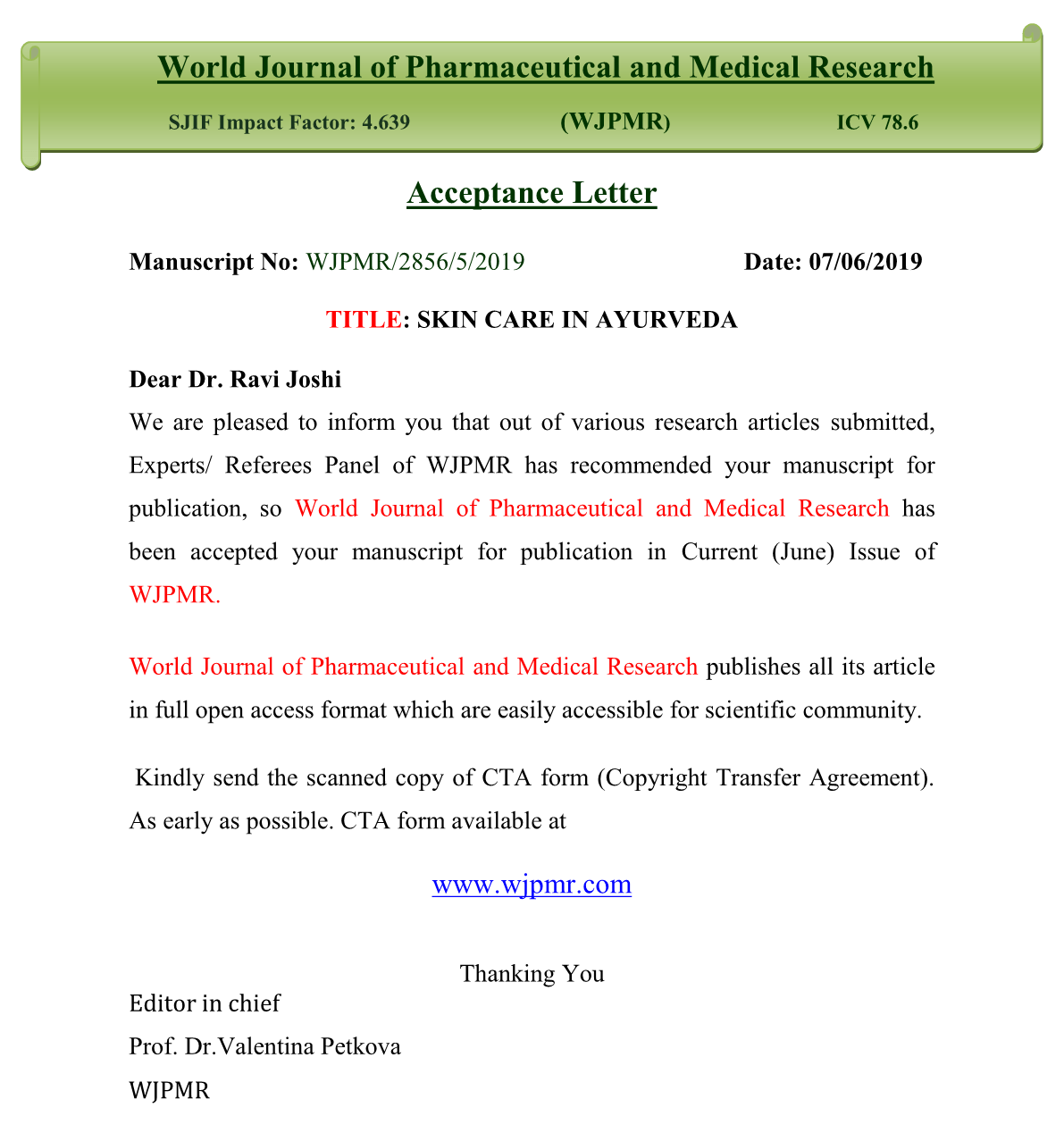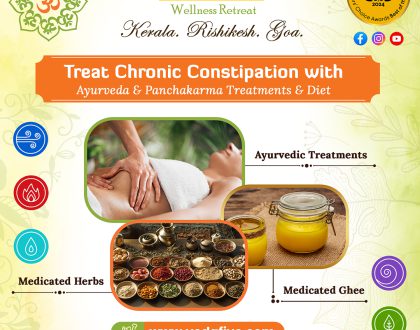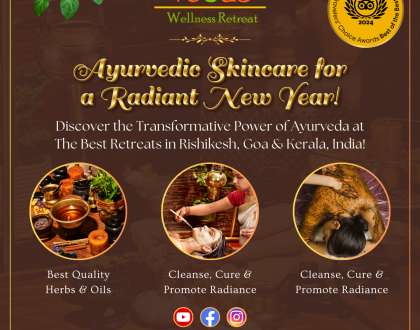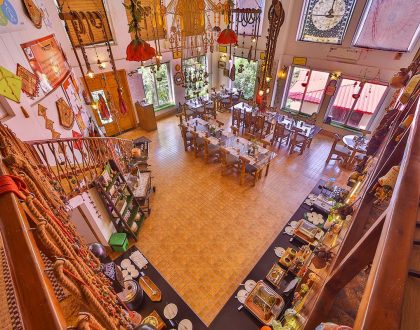Ayurveda Skin Care at Best Ayurveda & Panchakarma Retreat in Rishikesh, India
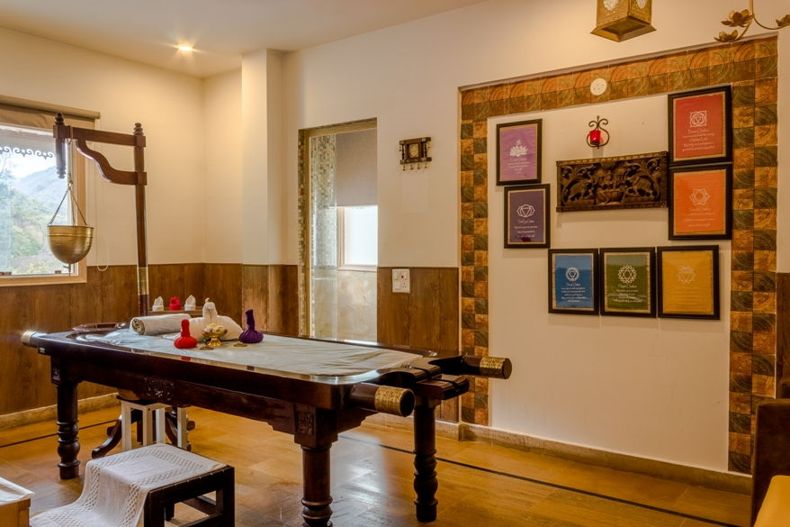
Skin Care in Ayurveda at Veda5 Wellness, Rishikesh (Himalayas), India
Author:
Dr. Ravi Joshi
B.Sc. & M.D. in Ayurveda
Senior Ayurvedic Consultant and Panchakarma Specialist
Veda5 Ayurveda and Yoga Retreat,
Rishikesh, Uttarkhand
ABSTRACT :- Skin is the best organ of the body interacting with the environmental agents like physical, chemical and biological agent. Interaction with these factors result in specific reaction pattern producing characteristic skin lesions in different parts of the body. The prevalence of skin disease becoming more due to the following factors – faulty diet and life style, excessive and improper use of chemicals-cosmetics, soap, shampoo, diodorants and exessive use of antibiotics and steroids.
Ayurveda has discussed all of skin disease under the name of Kushtha, and in other words it can be known as “Ayurveda Dermatology”. Kushtha are mainly divided into seven types of Maha Kushtha and eleven types of Kshudra Kushtha. Generally differential diagnosis and identification of a Perticualr Kushtha is very difficult as there are no clear tools presented in original Ayurveda texts. Disease of skin account for a great deal of Misery, suffering, incapacity and economic loss, including the genetic causes the diet, climate, sunlight mental factors and allergy etc., have been proved as aetiological factors beyond doubts. Natural hurbs seem to be more promising in the field of dermatology as already discribed in ancient Ayurvedic texts.
Key words :- Skin, Twacha, Kushtha, Herbs, Ayurveda.
Introduction :- The skin covers external surface of the body and is largest organ of body. It provied protection to the body1. It provide protection to the body in various ways from Microbes, abrasion, heat and chemicals2. Skin also contributes to thermoregulation of the body3. In Ayurveda, Twacha word is used for skin and derived from “tvac” dhatu, which means to ‘cover’4. The origin of the twacha is due to the combination of sukra (sperm) shonita (Ovum) in intra uterine life just like a cream on the surface of milk after boiling of the milk5. According to the Astang Hardyam skin originated from rakta dhatu in 6th month of embryo6. Just like a cream on the surfce of milk after boiling7. According to Ayurvedic concept every dravya is Panchbhotic in this world so twacha is also panchbhotic but it is considered as Prithivi and Vayu Mahabhuta dominant Panchbhotic organ.
Skincare is the range of Practices that support skin integrity, enhance its appearance and relieve skin conditions. They can include nutrition, avoidance of excessive sun exposure and appropriate use of emallients.
CONCEPT OF SKIN IN AYURVEDA
According to Ayurveda, twacha (Skin) is a seat of sparshaendriya. It’s consider as a gyanyandriya i.e. sense ogran. The developement of skin occures in third month of intra uterine life. The formation of skin results from heat generated in the process of union of sperm (Sukra) and ovam (Shonita) and formation of other body elements (dhatus) in foetal body. The Layers of skin according to Ayurveda are8–
| (1) Avabhasini | (4) Tamra | (7) Mansadhara |
| (2) Lohita | (5) Vedini | |
| (3) Shweta | (6) Rohini |
According to Ayurveda, twacha means skin which is related to vayu element (vatadosha). And bhrajakapitta situated in skin given colour to skin. Presence of sweat (swada) is essential for maintaining the health of skin9.
SKIN LAYERS ACCORDING TO AYURVEDA
| EPIDERMIS | DERMIS | |
| 1 | Hornelayer-Avabhasini | Malphagian layer-Tamra |
| 2 | Stratum lucidum-Lohita | Papillary layer-vedini |
| 3 | Stratum granulosum-shweta | Reticular layer-Rohini |
The layers of the skin are Epidermis and dermis.
Epidermis : – The epidermis is the outermost layer11. The epidermis layer provides a barrier to infection from environmental pathogens and regulates the amount of water released from the body into the atmosphere through transepidermal water loss. The epidermis is composed of multiple layers of flattened cells that overlie a base layer (Stratum basale) composed of columnar cells arranged perpendiculary.
Dermis :- The dermis, the skin’s next layer is a thick layer about 0.3 to 0.4 mm12 of fibrous and elastic tissue (made mostly of collagen) that gives the skin its flexibility and strength.The dermis contains nerveendings,sweatglands,hairfollicles and blood vessels.
SKIN CARE THROUGH AYURVEDA
Modern research trends mainly revolve around principles of anti-aging activity described in Ayurveda. The function of ayurvedic herbs is to purify skin and eliminate vitiated Tridoshas from the body as they are mainly responsible for skin disorders and other diseases. Several herbs have been mentioned in Ayurveda which can be used to obtain healthy skin and glowing complexion. Specific measurement for the enhancement of different aspects of beauty and disease conditions in relation to skin are mentioned in ancient Ayurvedic texts, they are described in brief.
| Properties | Ayurvedic Drugs / Herbs | |
| 1 | Vayasthapana
(Age-defying activity) |
Amrutha, Abhaya, Dhatri, Mukta, Jivanti, Mandukparni, Punarnava |
| 2 | Varnya
(Complex Promoters) |
Madhuka, Manjista, Sariva, Payasya, Sita, Lata |
| 3 | Sandhaniya
(Healing and Regenerative) |
Yestimadhu, Guduchi, Mochrasa, Dhatki, Lodhra, Priyangu |
| 4 | Vranropana
(Deep Healing) |
Sallaki, Laksha, Madhuk, Arjuna, Udumber |
| 5 | Tvachya
(Nurturing) |
Patola, Khadir, Arjuna, Karanja |
| 6 | Shothahara
(Anti-inflammatory) |
Chandana, Ashwagandha, Divdaru, Yestimadhu, Lodhra |
| 7 | Tvagrasayana | Amalaki |
Anti-aging treatment includes two types of therapies urjaskara (Promotive) and vyadhihara (Curative). For vata skin, skin care products that can nourish and rehydrate the skin should be used. For Piita skin, good skin oils and lepa should be used daily. For Kapha skin, a daily warm oil massage and cleansing of skin with specials types of medicated drugs and special lepa (Paste) should be performed.
In charak Samhita Chikitsa sthana and also sutra sthana13 explained of ten drugs as varnya (Complexion promoting) viz chandana (Santalum album), Punnaga (Calophyllum inophyllum), Padmaka (Prunus cerasoides), useer (Vetiveria zizanioides), Madhuka (glycyrrhiza glabra), Manjistha (Rubia Cardifolia), Sariva (Hamidesmus indicus). Paysya (ipomoea digitata), Sita (white variety of cynodon dactylon), Lata (black variety of
C.dactylon). In susrutha samhitha in the kshudra roga Chikitsa (treatment of minor diseases) many of the skin care treatments are documented14.
Arumsika (Eczema of face and scalp) – Washed with decoction of Nimba (Azadirachta Indica) than applies paste of Hartal (orpiment), Haldi (curcuma-longa), Paste of mulethi (glycyrrhiza glabra), Erand (Ricinus communis) and Bhringaraj (eclipta alba) Paste.
Vyanga (Black spot) and Nilika (Naevus) – Applied the paste of bark of kshira – vriksha (plant containing sap) or paste of Bala (sida cardifolia), Atibala (Abutilon indicum), yestimadhu (glycyrrhiza glabra), and Garika (Haematite).
Yauvana Pidika (Pimples/acne) – Applying the paste of
Vacha (Acorus calamus)
Lodhra (symplocos racemosa)
Sendhav (Rock-salt)
Dhanyaka (coriandrum sativum)
Kuth (saussurea lappa)
Astang Hridayam – Vagbhatta mentioned the benefits of mukhlepa as “Mukhalepanashilanam dridam bhavati darshanam, vadanam chaprimlanam shlakshanam tamrasopamam (22/22). The person who are habitual to application of paste of drug over face, the vision become keen, the face never dull and glows like lotus flower. Mode of application of paste over face, duration and precaution were also elaborality mentioned according to season.
| Grisma (Summer) – | Kumud (Nymphaea nouchali)
Khas (Vetiveria zizanioidis) Utpal (Nymphoeastellata) Chandana (Santlum album) |
| Varsa (Rainy season) – | Kaliyaka (Coscinium fenes tratum)
Til (sesamum indicum) Khas (Vetiveria zizanioidis) Padmak (Nelumbo nucifera) |
| Sharat (Autumn) – | Pundarik (nelumbo nucifera)
Mulethi (glycyrrhiza geabra) Khas (Vetiveria zizanioidis) Agru (Aquilari agallocha) |
| Hemant (Fall winter) – | Vasaka Root (Adhatoda vasica)
Ber (ziziphus Jujuba) Lodhra (Symptocos racemosa) Sarson (Brassica campestris) |
| Shisir (winter) – | Kateri root (solanum surattense)
Bark of daru haridra (berberisristata) Barly (Hordeum vulgare) |
| Basant (spring) – | Chandan (santalum album)
Khas (vetiveria zizanioidis) Shiris (Albizzia lebbeck) Saunt (Foeniculum vulgare) |
Astang samgraha15 :- Mukhdusika chikitsa (Acne) – Applicaton of warm paste of lodhra and Tuvarika.
Lancchana (Patches on the face), Vyanga (hyper Pigmentation) and nilika (naevus) chikitsa. The affected area covered with the paste of bark of tree having milky sap or that of Madhuka (glycyrrhiza glabra), Bala (sida cardifolia), Atibala (Abutilon indicum). Tender fruit of kapittha (feronia limonia) Tinduka (Diospyros Peregrine) and Rajani (curcuma Longa) and root of Amaliki (Tamarindes indica).
Other than some internal routine for glowing skin
Diet :-
Vegetarian diet.
Avoid- Fatty, Fried, Processed foods, Salt, Sugar seafood and red meat. Which is already mentioned in Ayurvedic texts i.e. – virrudh Aahara.
Sleep and Excerise :-
Excerise promotes sweatings, increase circulation, and calms the mind. Sleep and increase stimulate growth hormons which promote more production of collagen and elastin to keep your skin taut.
Yoga :-
It helps circulate the lymph and blood, tones the muscles cause proper ojas, vitality and glow.
DISCUSSION AND CONCLUSION :- Skin is one of the important presentable organ of the body. It has a definite role in ones personality. Hence skin diseases (twacha rog) affect not only on somatic level but also on a psychological level. Ayurveda ensures that the skin care therapies are effective from within the system by rebalancing the dosha derangements and cleanse the Rakta dhatu (blood) which nurtures the skin, by eradicating the impurities. Thoughtfully chosen ancient recipes and skin care rituals from the age old wisdom of Ayurveda help in combating the most commonly found skin issues of today.
REFERENCES
- The integumentary system, Principles of Anatomy and Physiology vol. I. John Wiley and sons.
- The integumentary system, Principles of Anatomy and Physiology vol. I. John Wiley and sons.
- The inetegumentary system, Principles of Anatomy and Physiology vol. I. John Wiley and sons.
- Williams m.m Tvac ; a sanskrit english dictionary. Adition 2010 : 463.
- Shastri A Garbhavyakarna Sharir sthana, Susrnt samhita Ayurvedatatva sandipika – vol.1
- Gupta K.A garbhakranti, Sharirsthana, Astang Hrdyam vidyotini hindi commentary, Chaukhambha orientalia Varanasi.
- Gupta K.A garbhakranti, Sharir sthana, Astang Hrdyam vidyotini hindi commentary, Chaukhambha orientalia Varanasi.
- Susruth Chikitsa sthana vol II English version by K.R. Srikanta Murthy. Chap 20. Choukhamba orientalia Varanasi.
- Structure of skin In Gold smith physiology, biochemistry and molecular biology of the skin. Newyork oxford university press 1991 : 3-62.
- Freinkle R.K. woodley D. The biology of the skin. Newyork Parthenon Pub group 2001.
- Structure of the skin- in goldsmith LA, Physiology, biochemistry and biology of the skin. 2nd ed. Newyork.
- Skin care in Ayurveda – A literary review by Kumar Sarvesh, Palbay satudru, Faculty of Ayurveda B.H.U Varanasi.
- Charaksamhita chikitsa sthana by R.K. Sharma english translation, Ch-VII treatment of Kustha. Chaukhambha Sanskrit Series Varanasi.
- Susruth Chikitsa sthana vol II English version by K.R. Srikanta Murthy. Chap 20. Choukhamba orientalia Varanasi.
- Vagbhatta, Astang Samgrah Uttarsthana Volume III English translation by K.R. Srikant Murthy Ch. 37 edition 2005. Chaukhamba orinetalia Varanasi.
Mind, Body & Soul
Veda5’s Ayurvedic treatments are supplemented with nourishing Ayurvedic food using fruits, vegetables and herbs as available from Veda5’s organic farm and highly-beneficial Yoga and Meditation sessions from experts.
Please see the Packages menu on our website to learn in detail about Veda5’s well-designed Ayurveda and Yoga wellness and vacation packages in Rishikesh, Goa and Kerala for which our guests come from around the world to India.
Click here to learn more about wellness through traditional Ayurveda and Yoga in Rishikesh, Goa and Kerala.
Click here to send us your booking requirements. You’re welcome to contact us for more details.
Veda5 looks forward to hosting you soon!

